Running a SaaS company can often feel like navigating through uncharted waters, where sustainable growth appears to be an elusive treasure.
In this dynamic industry, the quest for growth is a top priority, and one way to steer your ship towards calmer, more profitable seas is by crafting a winning SaaS specific SEO strategy.
What Is SaaS SEO?
Like all SEO, a SaaS approach to search is focused on making your brand discoverable to your target audience. Driven to scale quickly, many SaaS brands want to focus on PPC alone for rapid customer acquisition. However, that strategy neglects long-term, sustainable growth, which you can only achieve through SEO — and which is necessary to increase a SaaS brand’s ARR (annual run rate). Done well, SEO works in tandem with your other marketing channels, like content and outreach, to push your brand in front of the right audience and lead them to convert.
Consider this: In the ever-expanding digital universe, a SaaS SEO strategy isn’t just an option; it’s a lifeline.
It’s the cornerstone of your digital marketing arsenal and the surest route to a consistent flow of organic traffic. After all, statistics don’t lie – a staggering 73% of all business traffic starts with organic search.
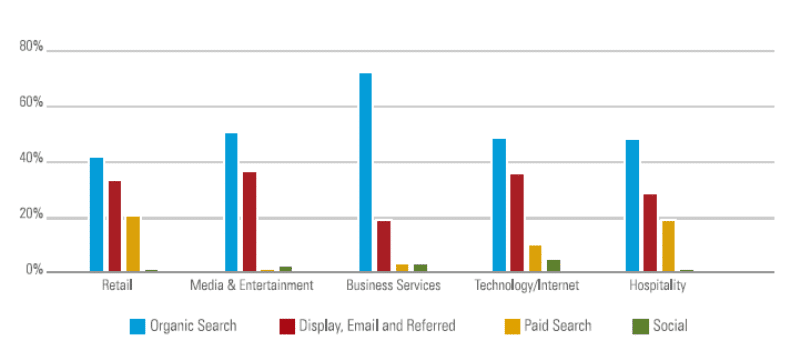
Now, imagine your SaaS product being effortlessly discovered by those who need it the most. Picture your brand ascending the search engine ranks, reaching out to your target audience with precision.
This is the power of a well-constructed SaaS SEO strategy – it’s your compass in the digital wilderness, guiding potential customers directly to your virtual doorstep.
At this point, if you’re asking yourself “great, so how exactly can I create an SEO strategy for my SaaS startup?”, your mind is in the right place. We’re about to do a deep dive into how to plan, execute, and measure the effectiveness of your SEO campaign.
But first, for those of you aren’t convinced, let’s look at the WHY.
Is Doing SEO for Your SaaS Company Even Worth It In 2024?
As a SaaS marketer, you’re probably wondering if SEO is even worth the time, effort, and investment.
Well, the short answer is yes. Though many SaaS companies see growth marketing (PPC, social ads, etc.) as their ticket to success, consider SEO the slow burn. Done right, SEO can create a strong, mutually beneficial relationship between your company and people who really need your solutions (even if they don’t know it yet).
In short, with SEO, SaaS companies can:
- Reach people searching for your software specifically
- Reach people searching for related software, even if it’s not yours
- Read people who want to learn more about software
- Reach people who want to purchase software but haven’t settled on a solution
SEO is a Predictable & Scalable Lead Acquisition Strategy
One of the biggest challenges in SaaS marketing is driving traffic and generating leads.
This is the challenge that SEO solves.
With an effective SEO strategy in place, ranking for your keywords becomes easier, resulting in you driving relevant organic traffic to your site and products.
Besides being one of the best ways of driving organic traffic, SEO also has the advantage of being scalable. Unlike other client acquisition strategies, SEO and content marketing are relatively affordable, no matter which stage of your business growth plan you’re on.
And once your SEO campaign is underway, gathering data to help you predict trends is super easy. This allows you to create better iterations of your campaigns.
SEO is an Excellent Way of Reducing CPA
Acquiring SaaS clients can be expensive. With other acquisition channels like PPC, the cost-per-acquisition (CPA) increases as the campaign matures. This is because you pay for every click. And as time goes on, you exhaust your relevant audience.
With SEO, however, it’s the exact opposite. Your CPA reduces as your traffic compounds with time. And unlike paid media, you don’t have to pay for every click.
SEO supports other channels and marketing strategies well.
From social media marketing to paid ads and everything in-between, every marketing channel can only work if the right people interact with your campaign. You can use SEO to improve the visibility of your other campaigns and drive traffic to them. It also plays a big role in helping drive conversions.
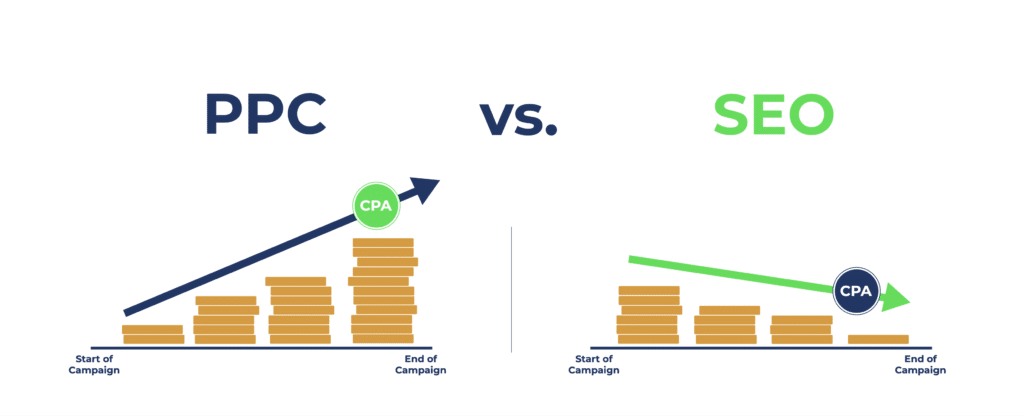
So, is B2B SaaS SEO worth it?
It certainly is.
That’s why we want to share our simple, actionable, and repeatable system with you.
Helps Build Authority and Trust
Another powerful advantage of SEO for SaaS brands is that it helps build authority and trust.
A well-executed SaaS SEO strategy results in your brand being more visible than your competitors. As a result, users will deem you to be a credible and authoritative source of information.
A couple of ways SaaS SEO helps you build authority and trust include publishing E-A-T content and building backlinks. Both signal to search engines and users that you are a reliable and trustworthy source for information and solutions in your niche.
When it comes to growing your SaaS brand, authority and trust play a huge role — especially if you’re just starting out. That’s because your target customers will be more confident in doing business with you.
SaaS SEO Special Considerations
Let’s start our SaaS SEO guide with some of the unique things about SEO for SaaS. Then we’ll delve into some general SEO best practices that are particularly effective for SaaS providers.
Competition From Content Aggregators
Keyword density is inherent to the way search engines sort websites. That makes it difficult for smaller websites to compete against larger ones, especially if they’ve been around for a while. There are numerous enormous sites with extensive listings of every kind of software or website.
Capterra is a top-rated aggregator site for software. They have over 800 different software categories alone. This is very difficult, if not impossible, for a newer or more independent website to rank against.
This also becomes a “chicken and the egg” scenario due to the other ways that search engines assess SEO. With Capterra being the go-to expert for all things software, that means that other websites are going to be linking back to them far more frequently than an independent website would.
Backlinks are just as crucial to SERP rankings as keyword density, if not more so. That means huge content aggregation sites like Capterra will continually pull further ahead while smaller websites lag further behind.
However, you can look at some of Capterra’s strategies to get an idea of how you can conduct your own SaaS strategies. You’ll notice they don’t just rank for high search volume keywords but also for many related long tail keywords as well. This is predominantly handled via the thoughtful use of solutions or use case pages.
Someone looking up ‘productivity software’ most likely doesn’t want to be led to just one product page. Instead, they probably want to see an assortment of options to choose from. That page should also include information that decision-makers will find helpful in making a decision. This is information such as customer reviews and pricing information.
You can use those insights as part of your SaaS strategy in various clever ways.
Getting Everyone On The Same Page
Product businesses are often large, complex systems. It can be difficult to get everybody on the same page, especially when dealing with enterprise scale growth planning. However, it’s imperative that you do so if you want your SaaS product to be competitive. This means getting your design and development team to work together with your SEO strategists.
Developers and designers usually focus on creating a great, well-functioning product efficiently and under budget. As a result, SEO is often an afterthought, putting these two teams at odds against one another.
Consider the simple metric of web page load time, for instance. Developers often want to include everything, and the kitchen sink into their application. This can lead to unwieldy applications that are slow to load, however. On the other hand, SEO strategists know that every millisecond counts when it comes to overall website load time.
40% of web users will leave a website if it takes longer than 3 seconds to load, after all.
To help avoid these disagreements, your development and marketing teams should get together semi-regularly. You should create a master list of the main key performance indicators (KPIs) that are most relevant for your SaaS product.
You should also agree upon the terminology that you want your software to rank for. This will help get the development and marketing teams on the same page when it comes to beginning your SEO campaign in earnest.
SaaS Has Longer Buyer’s Cycles
One final special consideration to keep in mind when promoting SaaS products is they feature a longer buyer’s cycle than other products. A study from HubSpot indicates that the average buyer cycle for a SaaS solution is 84.3 days. This means that a decision-maker will likely have to encounter a SaaS application several times before they’re ready to buy.
You can work these insights into your SEO plan. You’ll want to create content for each individual stage of the buyer’s cycle. You’ll want to think about keywords and phrases for different stages of the cycle, such as awareness or the consideration phase.
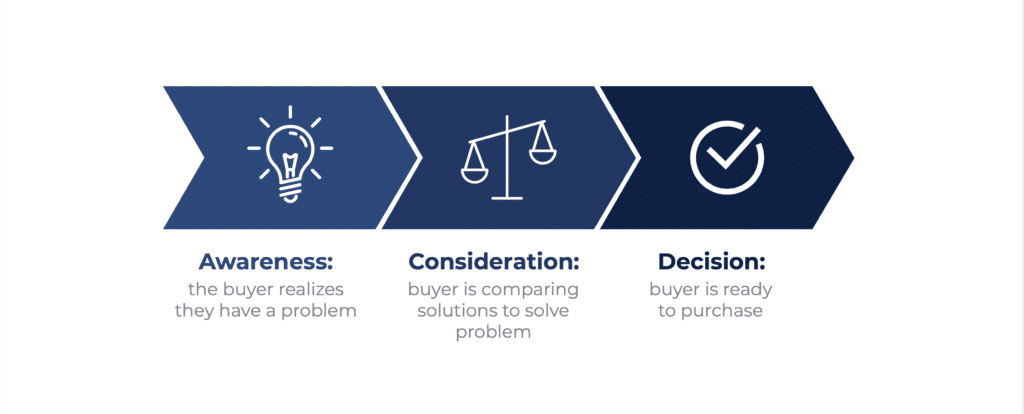
Don’t rely solely on solutions pages, either. You can also optimize blog content and more in depth resource content to target middle of the funnel buyers.
Understanding Search Intent
When some SaaS marketers think of SEO, they immediately think of the game beginning and ending with keyword selection.
Selecting the right keywords and conducting proper keyword research does play a significant role in SEO. However, as much as discovering relevant keywords plays a huge role in the success of your SEO campaigns, keywords alone aren’t enough.
You also need to know the reason people are using those particular keywords. This is called search intent, user intent, or keyword intent, and there are four main types:
- Informational. This is when a user searches to know more about their problem or your solution. Creating informational blog content, in depth guides, and product documentation is essential at this stage.
- Navigational. This is when a user knows the website they want to go to. Search queries that match this type of intent usually contain a brand name or even the web page the user wants to visit. A typical example would be “RevenueZen services page.”
- Commercial. People who fit this type of intent intend to buy soon and research products to solve a problem. They usually need some convincing, so developing great content that earns trust is essential here.
- Transactional. People searching with transactional intent are ready to buy and are probably looking for product pages. This is why you must ensure your “money pages” are optimized for search. Doing so makes it easier for you to appear for this type of search intent.
Understanding search intent is essential as it enables you to create the kind of content your prospects are looking for. This will result in you capturing more search traffic as Google (and those other folks) have become so sophisticated they understand the intent behind a query.
That’s why keywords alone won’t help you rank. You must marry keywords and keyword intent to get the best possible chance of ranking high on search engine results pages (SERPs).
As a SaaS business marketer, to get the best performance out of your search campaigns, you need to align your keyword intent to your buyer’s journey.
Doing this ensures that your content meets users’ needs at each stage of the buyer journey. As a result, your conversion rates will improve, even when targeting lower search volume keywords.
Top SaaS SEO Ranking Factors
With 3.5 billion searches happening each day on Google, there are many opportunities to get your brand seen. But as we know, the vast majority of clicks only happen on the first page of SERPs (search engine results pages). The exact formula and algorithm Google uses to rank pages is shrouded in mystery, but there are many ways you can help your website stand out and boost your chances of making it to the top spots.
Engagement
How do visitors interact with your site? That’s what Google’s looking for when it measures engagement. This includes dwell time (the total time a visitor spends on your site), what they click on and how they interact with your content, and how soon they leave (bounce rate). An engaging site demonstrates that your brand provides great user experience (UX) and quality content and is free of technical issues. Engagement may also look at how well your site is optimized for mobile and voice search and how it utilizes semantic search (connections between keywords and phrases that clarify search intent).
Links
Though it isn’t confirmed by Google, anecdotally, we can see that pages with more backlinks consistently rank higher. Surprisingly though, a majority of web pages have zero backlinks. If you want to improve your rank, you’ll need a linking strategy that includes both external and internal links.
- External: These are links that come from outside websites. It’s important that backlinks come from reputable sites with high domain authority.
- Internal: These are links from one of your brand’s pages to another. It’s important to carefully craft anchor text using keywords when possible, and link from high-authority pages to low-authority pages.
Content
Content and SEO are BFFs. Sure, you can have one without the other, but they’re always better together. When it comes to content, there are several factors that contribute to how your page is ranked:
- Keywords: How and where they’re used (H1s, H2s, meta tags, etc.)
- Length: Generally, the highest-ranked sites have long-form content, with the most effective being just under 2,000 words.
- Interlinking: How your pages are linked together with content from high-authority pages linking to other relevant pages. Topic clusters are ideal for this purpose.
Technical SEO
Most of the time, technical SEO is one of the first pieces of your SaaS SEO strategy you’ll want to tackle. Technical SEO addresses the issues that impede search engines from crawling and indexing your pages. If they go unnoticed or unaddressed, they will ultimately pull down your rank. Fortunately, technical SEO problems can be detected with a website SEO audit, and most can be fixed relatively quickly.
Domain Authority
Domain authority (DA), otherwise known as domain rating (DR) or trust flow (TF) depending on the SEO tool used, is a scoring system that looks at the content and quality of your backlink profile. Pages with higher DA simply rank better. You can increase your DA score by acquiring high-quality backlinks and by linking your high-performing pages to those that need a boost.
Why Do SaaS Businesses Need SEO?
Marketing your brand without an SEO strategy is a bit like screaming into the void — it might feel good for a little while, but ultimately, accomplishes nothing. For all intents and purposes, your brand doesn’t really exist without a SERP presence, and even then, you’ve got to be near the top to get real results. So why do SaaS businesses need SEO? The better question is: What are you missing out on without it?
Scale Growth
If you’re in SaaS, you know scale. Scaling your business is the ultimate goal, but it won’t happen without SEO. It takes well over a year for the most successful SaaS brands to reach $100K. From there, the milestones come quicker, but you’ll need an airtight strategy to get over the $100K hurdle.
The goal of any growth-focused strategy is to push through the so-called “blade years” and reach the curve that leads to hockey stick growth. But in order to get there and sustain that upward trajectory, you need an SEO strategy that brings consistent organic traffic and offers the content that pushes your audience through the funnel.
Stand Out from Competitors
At the start of this article, we mentioned the SaaS industry’s rapid growth. That means you’ve picked the right field to be in, right? Maybe. But it also means that every Tom, Dick, and Harry with a software programmer is thinking the same thing. No matter how amazing your product or how slick your website design is, if you aren’t beating your competitors in search, you aren’t beating them — period.
It’s not enough to out-think or out-design them in your product space. You’ve got to outrank them. And the only way to achieve that is through SEO.
Reduce Customer Acquisition Cost
We’ll be honest with you: PPC works. It’s a fantastic way to get your brand in front of a large crowd and drive quick traffic. But here’s the problem: The more successful your PPC campaign, the more your customer acquisition cost rises.
PPC offers a great growth injection when you’re launching a new campaign or featuring a new product, but as you tap your audience of ideal buyers, you’re eventually going to get more traffic that converts less — costing you more money.
SEO works in the reverse. There’s a bigger investment upfront, but once you have your strategy crafted and implemented, it should start driving organic traffic — which means free traffic. Your CAC goes down, while your traffic and conversions go up.
Support Other Marketing Channels
One of the great benefits of SEO is that it plays well with others. Other marketing channels, that is. In fact, in many cases, those marketing channels will depend on SEO for their continued success. We’d go so far as to say that you can’t have an effective SEO strategy without a great content strategy and vice versa. Good SEO will get your content seen. It will get your lead gen forms filled out and your emails opened. Without SEO, the rest of your marketing channels will not reach their full potential.
Convert Customers Across Multiple Channels
For SaaS brands, conversion is the endgame. Once you get leads, the conversion rate for qualifying them and closing the deal gets higher. But the conversion rate from visitor to lead is dishearteningly low.
Fortunately, SEO will work to get your conversions across your marketing channels. It will help ensure that the content you’re delivering hits the right audience with the right message, improving the chances of conversion. It will also ensure that your website offers an unparalleled user experience so your visitors want to stick around and won’t have to deal with technical issues that will drive them away.
Improve Customer Relationship
By now, you know that your customers aren’t just a number — each one represents a relationship between them and your brand. Great SEO helps define the relationship, and if they like it, you’d better believe they’re going to put a ring on it (or at least shell out their credit card info). As we’ve mentioned, SEO will improve your website, which improves the user experience — that means visitors won’t have a reason to stray.
How To Create Your Own SaaS SEO Strategy
To start our guide to setting up a SaaS SEO Strategy, let’s start with SEO itself. SEO stands for search engine optimization. It’s how a website or digital asset gets found by search engines.
All website owners can polish their SEO and content marketing efforts to get noticed by search engines.
However, there are some aspects of setting up a solid SEO strategy that is particular for SaaS providers. A SaaS strategy requires optimizing your content for standard SEO considerations and taking these special considerations into mind.
Some common SEO strategies for SaaS companies include:
- Creating individual solutions or use case pages
- Updating on page SEO factors like your title tags and meta descriptions
- Integrating rich content
- Finding guest posting opportunities
SaaS SEO strategies have some of their own unique considerations as well. There are often a rather limited number of users looking up SaaS applications directly, for one thing. Many of the top search engine result page (SERP) listings will automatically be taken up by huge content aggregation sites.
Luckily, you can configure your SaaS strategy to be more competitive by using particular keywords. You can also hone your strategy to increase actual conversions, which is the main point of SEO anyway.
1. Choose Your KPI Targets & Goals
One of the very first steps you must take when creating your SEO campaign is to set goals and define your key performance indicators (KPIs).
To achieve SaaS SEO success, you have to know what success actually means to you. Otherwise, you’re just chasing the gold at the end of the proverbial rainbow. Your goals also narrow your focus. If you know what you want to happen, you can reverse engineer the tactics it’ll take to get you there.
While it’s tempting to just rush headlong towards getting as many sign-ups as possible, pick something specific and measurable.
Your goal may be something like: Increase monthly recurring revenue (MRR) by $X over X months.
With that goal in mind, set some KPIs that you’ll track regularly. Take into account both SEO KPIs and KPIs relevant to your business.
Common SEO KPIs are:
- Rankings
- Impressions
- Traffic
- Leads/conversions
Common SaaS KPIs are:
- Marketing-qualified leads (MQLs)
- Sales-qualified leads (SQLs)
- Monthly recurring revenue
- Cost per acquisition
Every SEO tactic you take should ladder up to these KPIs. Measure on a regular basis to check your progress, but make sure you give your new SEO time to grow.
A huge caveat with SEO is that it sometimes takes a long time to see your campaign results. This is where setting goals and defining KPIs are very helpful. They help you keep your eyes on what matters most. They also help you remain focused even when it may seem as if there’s no movement behind the scenes.
So what are some examples of goals you can set as a SaaS business?
- Lead generation
- Trial/demo sign-ups
- Brand awareness
- B2B Sales
- Activating dormant users
Some of the primary KPIs You can use to track the performance of your campaigns include (among others):
- Unique visitors
- Cost per conversion (demos booked, meeting booked, & contact forms)
- Total monthly conversions
- Monthly conversions by channel
- Total keywords ranking in positions 1-10 for target keywords
- Top content (by new users, conversions)
- New users by channel
- User > lead conversion rate
- Lead > customer conversion rate
The KPIs you use will largely be dependent on your business model, campaign goals, and other unique qualities that make up your industry vertical.
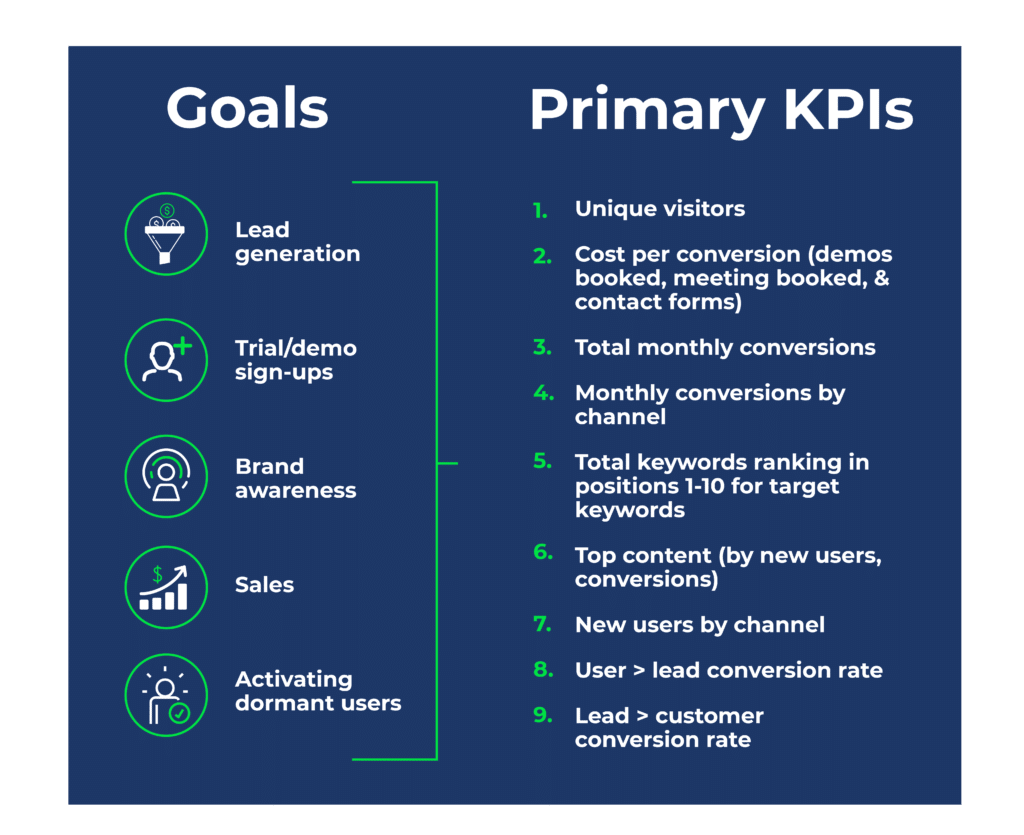
2. Conduct In-Depth Keyword Research
Every SEO campaign should begin with keyword research. Otherwise, you’re simply guessing rather than using your time, energy, and resources most efficiently. The problem is that many SaaS providers don’t have a simple, straightforward keyword for their product or service.
Many SaaS providers feature extremely niche products. They tend to think in terms of copywriting rather than keywords, “empowering end-users by freeing data from its siloes,” which sounds nice but doesn’t feature one definitive keyword or phrase with proven search volume.
This is where competitor research comes in. Even if your SaaS product is entirely new and innovative and you have no direct competitors, there’s bound to be some sort of application that does something similar.
Your competitor analysis might’ve yielded a good keyword list. While that’s a solid starting point, we always recommend adding to it since there’s a good chance your competitors aren’t ranking for every single relevant keyword (and if they are, it’s really time to get cracking).
Good keywords aren’t just one or two words. In fact, shorter keywords can be the hardest to rank for, and 91.8% of search queries are actually long-tail keywords.
With that in mind, consider the following:
- Questions your prospects have
- Challenges they face
- Relevant, related topics
These are all great sources for keywords. And once you’ve built that list, it’s time to sort it.
Start by sorting your list according to where those keywords fall in the buyer’s journey. These are:
- Top-of-funnel: People searching these terms are looking for a solution, but aren’t necessarily ready to subscribe.
- Mid-funnel: Prospects at this stage know they have a problem; they know a software solution exists, but they haven’t started researching products just yet.
- Bottom-of-funnel: When people search these keyword types, they’re ready to buy and just need to be shown the way.
Within each of those groups, categorize the keywords based on their difficulty level. These are:
- Low difficulty: These are usually longer-tail, lower search volume keywords. They’re easier to rank for and may be good to target at first.
- Medium difficulty: These keywords are more competitive, but they may also be further down the funnel — a great thing when you do start to rank for them.
- High difficulty: These are short, highly-competitive keywords that are often bottom-funnel. Think of terms like “education software” or “SEO software.” Short, competitive terms can be a good fit for product pages.
Think about some of the applications that inspired you to create your SaaS business in the first place. Also, think about any others that you might have learned from during development. As it gets closer to implementing your SaaS strategy in earnest, use some of those sites to conduct competitor research.
You should also spend some time on some of the leading software directories like Capterra. You might come to find that other software solutions aren’t really optimizing their content for SEO, whereas Capterra is always clean, clear, and well organized. This could yield potential opportunities to pull ahead in SERP rankings.
Software listings on Capterra have a section where they show where they’re listed. Like with Google Drive, for instance, which is listed as ‘file-sharing software,’ ‘remote work software,’ or ‘document management software.’ These listings will give you further ideas for additional keywords to optimize your content for.
You can do the same for other software in those categories, as well. You’ll have a full list of keywords to create content around before you know it!
Keyword Research Process
So, how do you conduct effective SaaS keyword research that helps you rank for imp[ortant industry terms?
Here’s a sneak peek into how we do it for ourselves and our clients:
- Gather the right information: This stage involves brainstorming relevant topic ideas, reviewing any brand verbal identity materials checking out the type of content competitors are publishing, and interviewing subject matter experts (SMEs).
- Use keyword research tools to analyze and discover keyword ideas: Keyword research tools like Semrush, Ahrefs, and many others are invaluable in helping you know which keywords to target and rank for. These keywords are essential to designing an impactful inbound lead generation strategy.
- Filter your seed list: Once you’ve compiled your list of keywords, called a seed list, filter out irrelevant and low impact keywords. You can use factors like search volume and keyword difficulty for this. You can also filter out one-worded keywords as they are difficult to rank for. Instead, target longtail keywords.
- Map your keywords to search intent: Search intent is the reason for a particular search query. Understanding search intent is crucial to creating content users find relevant and helpful.
- Review your remaining keywords for prioritization: By this stage, you should have filtered out a lot of keywords, remaining with those that matter to your business. Take these keywords and sort them according to priority.
- Align your keywords to current and future content assets: Align each keyword to important assets. If you have published content, you can map keywords to current assets that need refreshing. Otherwise, build new content assets using those keywords.
- Track keyword performance: Once you’ve created or refreshed your content, make sure to track the performance of each keyword. Tools like Google Analytics are great for this.
With your keywords sorted, you now have a strong foundation for an effective SaaS SEO strategy.
3. Analyze Top Competitor Strategies
After you’ve spent some time gathering your seed list of keywords and phrases on platforms like Capterra and other keyword research tools, the next step is to go back to Google. Start looking through the SERPs to find additional web pages not listed on Capterra. You’re going to do competitor research on those sites, as well.
Chances are, you know who your competitors are. But when it comes to SEO, there are two key distinctions:
- Marketplace competitors might not be your SEO competitors.
- Any site that’s ranking for terms you want to rank for is a competitor, even if they aren’t a software provider.
Let’s break that down.
There may be SaaS companies you consider massive competitors because they offer a similar product or solve a similar problem. But if they’re not pursuing SEO, they aren’t your competitor in this channel. There may also be non-SaaS sites ranking for SaaS-related terms. You guessed it; those sites are now your competitors, too.
Now, the competitor analysis begins. You can enlist a trusted partner or a comprehensive SEO tool to answer the following questions about your competitors:
- What keywords are they ranking for?
- How are they ranking for those keywords?
- What content types are they using?
- How long is the content they publish?
- How often do they publish content?
What do I need to do to beat my competitor?
Next, you’ll want to go to some sort of keyword research tools like Ahrefs or Moz. On Ahrefs, you can investigate a domain by Prefix. This returns a list of all of the keywords a website ranks for.
You’ll also get a listing of posts that are performing particularly well for particular keywords. You can browse those keywords, as well. And with any luck, you won’t see Capterra among those listings.
This will give you an idea of keyword alternatives that you can rank for and aren’t already dominated by the content aggregation sites. That’s the bright side of SaaS SEO, which focuses more on long-tail keywords than immediate results.
4. Audit Your Existing Content and Identify Improvements
A content audit is another essential element of a B2B SaaS SEO strategy.
If you’re wondering, a content audit means running a performance-based analysis of your website’s content. Using SEO and user behavior metrics, your audit will reveal the strengths and weaknesses of your content marketing. It can also reveal opportunities you can leverage to improve your SEO results.
Some of the SEO and behavioral metrics you can use to audit your content include:
- Organic traffic
- Time spent on page
- Pageviews
- Bounce rates
- Conversion rates
- Backlinks
- Internal links
- Word count
- Stage of buyer’s journey (top of the funnel, middle of the funnel, bottom of the funnel)
These metrics will give you insight into the pages that perform well and those that don’t. For those that don’t perform as expected, further analysis will reveal whether they should be optimized or deleted altogether.
You can also use the targets from your keyword research findings and map them to pieces of content that need updates.
Okay, so how do you conduct a content audit? Here are a few steps to help guide you along:
- Understand the goals of your upcoming campaign and define relevant metrics.
- Inventory your content, taking into account all relevant pages.
- Collect and analyze the data for each page using your defined metrics.
- Create an action plan based on the data you’ve analyzed.
There are many different tools you can use for this. Examples include Ahrefs, Google Search Console, Semrush, Screaming Frog, and a whole host of others.
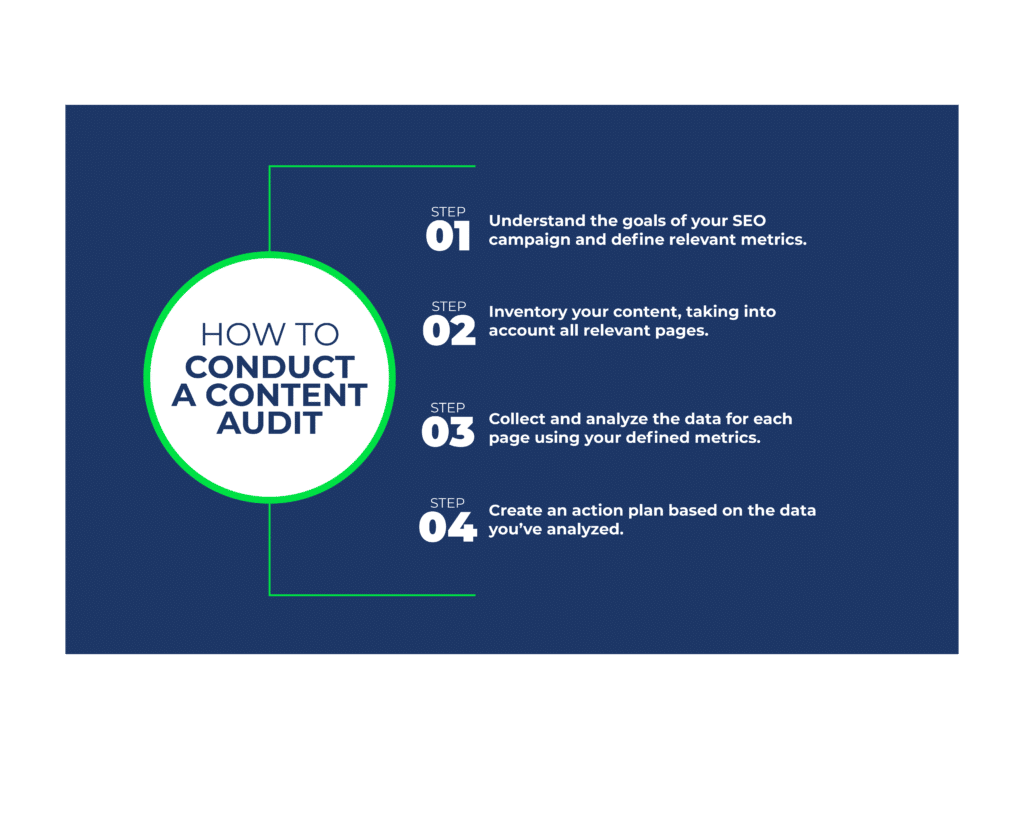
Adjusting your content marketing strategy according to the results you get from your content audit is a great way to boost your SEO. Not only does it result in increased traffic to your site, but it also leads to improved conversion rates. That’s why content audits must be an integral part of your broader inbound marketing strategy.
5. Build Relevance and Improve User Engagement Through On-Page SEO
On-page SEO may seem like a basic fundamental. However, it plays a huge role in the way your pages rank and how users interact with them.
What is on-page SEO?
On-page SEO is the practice of optimizing the elements on your website so that your web pages rank higher. The purpose of on-page SEO is to make it as easy as possible for search engines and users to understand what the content on a page is about. On-page SEO best practices also help you create pages that are easy to read. The result is better rankings and higher engagement.
The main on-page SEO considerations to prioritize include:
- Title tag: A title tag is an HTML code that serves as a webpage’s title. It’s one of the prominent elements of a snippet on SERPs. An optimized title tag is essential in boosting your clickthrough rates (CTR). Include your keyword in the title tag, preferably close to the beginning. Also, keep it as short as possible to avoid it being truncated on SERPs.
- Meta Description: This is another important element of your page’s snippet. It’s a short description of what your page is about. In essence, it’s a short sales pitch designed to encourage users to click on your snippet. Include your focus keyword and its variations in a natural way. Try and keep it within the 160 character limit set by Google.
- Header tags: Header tags are the titles of each section of your page or post. They are also HTML elements and rank in priority from H1 to H6, with H1 usually being the page’s heading. You should include your focus keyword in at least one header tag and use your secondary keywords or variants in the others if possible.
- Relevant URL: Your page’s URL (web address) is an essential element that needs to be optimized for users and search engines. A couple of ways to do so are including your focus keyword and keeping it short. Also, try to make it as descriptive as possible.
- Image alt tags: Image alt tags are meant to improve your page’s accessibility. They are also a powerful on-page SEO element not to be neglected. Make them as descriptive as possible and ensure you use your keyword naturally wherever possible.
- Links: Links, especially internal links, should also be part of your on-page SEO strategy. Link to relevant pages on your site and use descriptive anchor text. Doing so helps give context to your content.
Last but not least, make sure your content itself is optimized and offers in-depth information on the topic. It must also offer a good user experience to ensure users stay on the page longer.
6. Perform Your On Page SEO and Technical Optimizations With High Priority Issues In Mind
Effective SEO requires that you take a holistic approach to your campaigns. That means you must focus not only on content but also on the technical aspects of your website.
You must regularly conduct a technical SEO analysis to ensure everything is optimized as far as technical issues are concerned.
One thing to note is that not all technical issues are created equally. As such, you must prioritize issues based on:
- Impact they have
- Resources available
- Company needs (for example, traffic bandwidth)
Some of the basic technical and on page SEO elements to keep an eye on include, among others:
- Website and pages are being crawled and indexed properly
- SSL certificate is set up properly
- Adequate internal linking to key pages
- No status errors, 404s, 503s, etc
- Core web vitals and load performance
- Title tags, heading tags, and meta descriptions
- Url structure and navigation is optimized
Again, this can be done with the help of some SEO tools like Google Analytics, Screaming Frog, Website Grader by Hubspot, and many more.
Optimize for Technical SEO
You might see technical SEO referred to as low-hanging fruit, but that’s no reason to neglect it. Technical SEO issues are often easily detected through a website audit, and an experienced tech SEO expert can make adjustments that can give your SERP rank a boost.
Remember, like all SEO, it’s not a one-and-done approach. The biggest investment (in time and money) will happen at the beginning, but you’ll want to continue regular monitoring and maintenance so nothing falls through the cracks. Technical SEO issues can be easily remedied, but if you don’t know they’re happening, they can set back your strategy and delay your results significantly.
Optimize for On-Page SEO
The same is true for on-page SEO. It’s tempting to think that making a few tweaks to your web pages means you’re all set, but that’s not reality. It’s important you continually keep an eye on what’s happening on your pages, including site structure, content, CTAs, and much more.
Both on-page and technical SEO tactics will provide a better user experience. As we now know, this is one of the most important things Google is looking for when crawling and indexing your site. Making these adjustments regularly will ensure your site makes it higher on SERPs and gets in front of the audience you want.
7. Create Product/Solution Pages Based on Customer Pain Points and Jobs To Be Done
Once you’ve got a list of the target keywords you’re hoping to rank in, you’ll want to begin creating solutions pages integrating those insights.
Solutions pages are of particular importance for a successful SaaS SEO strategy, as you have complete control over what’s included. They also allow you to optimize content for keywords at the bottom of the funnel.
There are a few types of these pages that are of particular importance for SaaS applications.
Create a Content Distribution Strategy
As we’ve noted, where your content lives is almost as important as what’s in it. You want to create a content distribution plan that is holistic and robust and delivers the right content to your audience, wherever they are.
List out all of your owned, earned, and paid channels, and build a strategy to ensure your content hits all of them. This may include using PPC for a quick growth injection at the start of a campaign, using digital PR to get prime media placement, or coming up with a content delivery schedule for your blog and social channels.
Remember that some content formats perform better on different channels, so consider that carefully when you’re building out your content strategy.
8. Know Your Customer
Only 35% of SaaS companies have a central document that describes their customers. If you’re not one of them, take time to create one. And no, we’re not talking about a thin profile on “SaaS Susie.” Talk to both your marketing and sales teams to determine the psychographics — not demographics — that your most valuable customers have in common.
These could be things like:
- Personality traits
- Lifestyles
- Interests
- Attitudes and opinions
- Values
If you are among the one-third of SaaS companies that already have a buyer persona, make sure that it’s relevant to SEO. It is possible and even likely that the customer coming through Google will be a little different than the PPC customer. Identify what those differences are so you can develop content that will add value to their work and life.
If you don’t already have a detailed buyer persona, now is the time to create one. Your buyer persona is different from your target audience in that it has more detail and offers an in-depth look into your customer’s psyche. Even if you’re a relatively new SaaS brand or startup, you can still put together a buyer persona with a little bit of digging.
- In-house interviews: Talk to team members about their perceptions of your existing customers. Since sales typically has the most interaction, that would be a great place to start.
- External interviews: Take your questions directly to the consumer. Send out a survey or conduct in-depth interviews with a handful of your top customers.
- Data analysis: The numbers don’t lie, so turn to them for information on your existing customers’ demographic data.
Remember that you may have several buyer personas, especially if you offer different services or packages. Additionally, don’t limit your persona to demographic information only. You’ll want to include psychographics and behavioral attributes as well.
Solutions Pages
Product solutions pages are the heart of a SaaS website. They’re where you describe, in as great of detail as possible, what your SaaS product is and does. In addition, product pages are where you want to focus on the main keywords you want to rank for.
This also means that those target keywords are also going to be some of the most competitive. It’s going to be difficult to stand out against the content aggregation sites. The ones that do often focus on page design and the amount of content on the page.
To help your product pages perform competitively, you should include one or two instances of the main keywords before the first call-to-action. Rich content, such as a product demonstration video, will also make your product page more SEO-friendly.
You’ll want to include some graphics on your product landing pages, as well. High-quality screenshots are an easy way to integrate graphics. So are logos and graphic design.
Remember to include the keywords you’re hoping to rank for among the alt. title and meta description of the images you upload. One of the main keys of a successful SEO strategy is taking advantage of every opportunity.
Features Pages
Features pages are very common on software company sites, as well. These fulfill multiple functions. First and foremost, they tell your customers what your SaaS application can do. They also help optimize your site for SEO.
Feature pages can be stacked, as well. You can have an overview page similar to a category page. Then you can have each individual feature lead to its own landing page. This gives you even more opportunities to integrate the keywords to help your site get found more often in search.
SaaS SEO strategy isn’t that dissimilar from traditional SEO, but it has some unique challenges. Following this guide will get you thinking like an SEO strategist, helping you to construct methodical SEO and content marketing campaigns that will have you ranking competitively as quickly.
Industry Vertical / Target User Pages
Personalization has become an essential aspect of successful B2B marketing.
But with the buying decision in the hands of committees, how do you personalize B2B marketing, especially from an SEO and content perspective?
This is where industry vertical pages come to the rescue.
Industry vertical pages are created to target a particular industry vertical specifically. Because of this, the pages focus on that industry’s major pain points. As a result, your target audience will relate to your content, leading to your gaining credibility.
For example, one of our industry vertical pages is the B2B SaaS SEO Services page. We clarify which industry we serve and the challenges we help players in that industry overcome.
Building industry pages also has the advantage of helping you send important signals to your target audience.
- Similar companies use your product
- You solve industry-specific problems
- You understand and value your target’s audience
As a result of these signals, your content will be primed to convert better and generate higher-quality leads.
9. Understand Search Intent
Keywords are critical to SEO, but the days of picking the highest-volume keywords to appeal to the largest audience are behind us. We now know that low-volume keywords can be even more effective if they’re aligned to search intent.
You’ll need to understand the search intent for each of your buyer personas, wherever they are in the funnel. Once you have a good grasp on that, you’ll be able to select low-volume, high-intent long-tail keywords that get you in front of the exact right audience.
10. Create Valuable Resource Content That Educates Your Potential Customers
An element of SaaS SEO that’s often neglected is the quality of content needed to rank.
With over 5 million blog posts published per day, the competition for the top spot on SERPs is pretty fierce. This is why you must differentiate yourself by producing in depth and most importantly, technically accurate content.
Besides ensuring top-notch quality, you must also create targeted content. This means creating content aimed at the different stages of the funnel your target audience is at. The goal isn’t to throw any old blog at the SERP and see what sticks. It’s to create valuable, thorough content that is:
- Better than whatever your competitors publish
- Uniquely helpful to whoever is searching those terms
Use those two points as your litmus test. Any content that doesn’t meet those criteria does not pass go. Ever.
So what content should you green light? “Better” content can mean content that is:
- Longer
- More specific/in-depth
- Includes more helpful images and/or videos
- Answers additional questions your prospects have
- Easier to read
Using your keyword research and understanding of search intent, create content targeted at the:
Top of the Funnel (ToFu)
Top of the funnel (ToFu) content is designed to drive traffic and boost brand awareness. As such, it must target high volume, low competition keywords. ToFu content is usually informational and has little to no sales value. This is why ToFu always starts with keyword research and focuses on traffic-generating blog posts. By answering the questions users are asking, you get to attract them to your website and product.
Middle of the Funnel (MoFu)
MoFu content is educational by nature and helps users solve a problem using your service or product. Its main purpose is to help users at the evaluation stage decide to go with your product. Examples of MoFu content include “How-to” articles, webinars, surveys, and downloadable assets.
The best way to develop MoFu content ideas is by looking at common customer pain points and aligning them to your product’s features.
Bottom of the Funnel (BoFu)
BoFu content is designed to drive sales. Because it’s conversion-focused, it should promote your product as much as possible. Examples of BoFu content include product demos and trials, case studies and testimonials, spec sheets, and more.
Since it’s designed to sell, BoFu content must be built around your product. It must be created in a way that makes your product the hero of your customer’s story.
For each content type, define clear goals and outcomes. Bonus points for getting SMEs to help with the content creation process.
Post-Purchase Keywords
So, you’ve got your buyer personas through the funnel — your work here is done, right? Not exactly. Especially in the world of SaaS, a loyal customer is the best customer. What’s better than the best? A loyal customer who refers others to your brand. See, the funnel goes down and ends in conversion…except it doesn’t actually end there. The post-purchase funnel goes in the opposite direction, expanding according to how you nurture your new customers.
At this point, you want to focus on customer adoption and support. Consider long-tail keywords that use phrases like “how to use X product feature” or “X brand troubleshooting.”
Post-Purchase Keywords
So, you’ve got your buyer personas through the funnel — your work here is done, right? Not exactly. Especially in the world of SaaS, a loyal customer is the best customer. What’s better than the best? A loyal customer who refers others to your brand. See, the funnel goes down and ends in conversion…except it doesn’t actually end there. The post-purchase funnel goes in the opposite direction, expanding according to how you nurture your new customers.
At this point, you want to focus on customer adoption and support. Consider long-tail keywords that use phrases like “how to use X product feature” or “X brand troubleshooting.”
Use Comparison Keywords to Poach Unhappy Customers from Your Competitors
As we mentioned in the bottom of the funnel keyword section above, when your buyers get deep into the funnel and are aware of their problem, the solution, and how your brand’s product delivers, they’re ready to start comparison shopping. At this stage, they aren’t just looking for the best brands — they want to know what sets your brand apart from the crowd.
This is where you’ll find you get the most out of comparison keywords, such as “Your Brand vs. X Brand.” Aim for keywords that target any areas in which your brand shines. Do you offer the same service at a lower price? “Your Brand vs. X Brand Pricing.” Jam-packed with features no one else has? “Your Brand vs. X Brand features.” You get the idea.
Identify Low-Hanging Fruits
If you’re wondering where to begin tackling your keywords to improve your rank, go for the easy pickin’s. Sort all your pages by current rank, and look specifically at those ranking from the bottom of page one through the bottom of page two.
This is the low-hanging fruit, and it presents an opportunity for quick growth. Since these pages are already ranking for your priority keywords, they have built up some authority. That means search engines are taking notice, and a few simple on-page adjustments could be exactly what’s needed to push them up in SERPs.
Adopt a Topic Cluster Approach
Think about the keywords you want to rank for and the specific topics these represent. A topic cluster is a group of content structured around a central pillar page, with content pages radiating out from the center.
Internal links connect all of these cluster pages to the pillar page and to one another. This helps build authority and lets search engines know exactly what your content is about. For example, you might have a pillar page around the keyword “Pizza.” Your cluster pages, connecting back to the pillar page, could include “Pizza Recipes,” “History of Pizza,” “Deep-dish vs. Thin Crust Pizza,” and more.
11. Update Existing Content
This is a great approach for brands that are short on time or budget (or both). You don’t have to recreate the wheel to have high-quality, high-ranking content. In fact, refreshing and repurposing old content is one of the most reliable ways to give your brand a boost in search. It’s nearly always quicker and more effective than starting from scratch.
The big question is how “fresh” do you want your updated content to be?
Map Your SEO Strategy to Your Marketing Funnel
We’ve already talked about choosing keywords for each section of the funnel. But you really want to make sure your entire SEO strategy follows the different stages of the funnel and answers your buyer persona’s needs wherever they are.
Remember that mapping your strategy to the funnel means mapping your content as well. You don’t want to push mid-funnel content to a user who doesn’t even know what their problem is yet. And you don’t want to push top-funnel content to someone who’s already in the decision stage.
Conduct Competitor Analysis
Remember — this isn’t just who you think your competitors are — you need to understand which brands are out there offering the same services to the same audience. Start by looking at the keywords you’re targeting and identifying the brands ranking for the top three spots. You can also use an SEO tool like Ahrefs or Semrush to help identify your competitors.
Once you know who they are, it’s time to get out your magnifying glass and start sleuthing. You want to look at:
- Their content: Find out the kind of content they offer. Look at quality, length, and whether it’s aligned to search intent.
- Their distribution: Where they’re pushing out their content is just as important as what the content says. If they’re distributing in places you aren’t, you’re missing an opportunity.
- Their backlinks: Who’s linking to your competitors? Are there opportunities for you to acquire backlinks from those same sites through guest posting or other methods?
The goal of your competitor analysis is to uncover gaps you can fill with content, distribution, or outreach that is done better and answers the pain points and needs of your buyer persona.
Create Content That Goes Deeper Than Everyone Else
If you want to compete, you need to be on your A-game when it comes to content. But what does better content really mean? We can tell you what it doesn’t mean — more. In this case, just pushing out a massive volume of content will use up your resources without driving meaningful results. It’s better to have 100 great blogs than 1,000 mediocre blogs.
Here are some of the factors that contribute to content quality:
- Length: When it comes to length, your goal should be to hit the sweet spot. Generally, that’s just shy of 2,000 words.
- Multimedia: Incorporate images, infographics, video content, and more to create a more engaging experience.
- Layout: Break content into easily digestible segments. Use H2s and H3s, bullets, and lists to make the content scannable and snackable.
- Detail: This doesn’t just mean longer. Go in-depth on a very narrow topic, and give more information on it than your competitors.
This is where understanding search intent will help you craft content that is more meaningful and more likely to convert.
Publish Evergreen Content
Much like SEO, the results of good content compound over time. Creating evergreen content is a fantastic way to maximize impact as traffic and engagement will continue to grow. You’ll probably want to regularly update this content and refresh the date in order to balance timelessness and timeliness, but overall, well-done evergreen content is the gift that keeps on giving. Wondering what makes the best evergreen content?
Generally speaking, top-of-the-funnel content is well-suited to be evergreen. However, some bottom-funnel content, like how-tos for existing customers, can also continue performing well into the future.
12. Optimize, Optimize, Optimize
Oh, you thought you were done once you hit “publish?” Not so fast.
Yes, true success in SaaS SEO is about creating great content. But it’s also about the tweaks, changes, and improvements you make over time. It’s turning tired old assets into shiny, new, rankable pages. It’s updating old content to keep it fresh. It’s adding to blogs as needed lest your competitors get the better of you.
You should tackle this from three different angles:
- Technical SEO: This is the practice of cleaning up any site errors. Many SEO tools can audit this, but, generally, you want to make sure links/buttons work, pages are indexed and marked up, and you’re creating a bug-free user experience.
- On-Page SEO: This is making improvements to the content itself. It might be ensuring that you have proper headings and that the content is easy to read, but it might also mean adding depth to the content itself to boost your rankings.
Off-Page SEO: These are activities that happen outside of your website but can still impact your SEO success. Think backlinking, driving branded searches, and increasing social media engagement.
13. Build Domain Authority and Reputation with Focused Link Building (More On Off Page SEO)
A critical element of B2B SaaS SEO is to build your reputation, domain authority (DA), and domain rating (DR). That’s because the higher your DA and DR, the more search engines trust you to serve relevant and helpful content.
So what exactly are DA and DR?
- Domain Authority (DA): DA is a metric developed by Moz to help predict the likelihood of a website to rank high on search engine result pages (SERPs).
- Domain Rating (DR): This is an Ahref’s developed metric that shows the strength of a website’s backlink profile. The backlink profile is compared to others in Ahref’s database and is rated on a scale of 0-100.
Both these metrics are essential to running an effective SEO program. The good thing is you can develop strategies to boost your DA and DR.
By pushing your DA and DR up, the chances of your content ranking higher improve.
How do you boost your DA and DR?
One of the most effective ways to boost these two metrics is to build backlinks.
Not only will link building boost your DA and DR, but it can also help you tap into the traffic of the referring domains. As a result, you can also drive new customers from this strategy.
While link building is one of the least sexy disciplines in digital marketing, it’s an integral part of an effective B2B SaaS SEO strategy. Here are a few tips to help you pull off a successful link building campaign:
Conduct Original Industry Research
One of the best link building strategies is to conduct and publish industry research. Not only does this help build your reputation, but it’s an excellent way to build backlinks quickly. That’s because every publisher wants to give their content more authority. And the best way to do that is to cite stats and facts.
Publish “Best of” and Roundup Posts for Different Software
Another great way to attract backlinks is to publish or participate in “best of” posts and “roundup” posts.
- Best of posts: these are posts where you compare different products in your vertical. Done well, the vendors you feature will also link back to your pots.
- Roundup posts: These are posts where you aggregate opinions from industry experts. Each expert contributes their opinion and gets a backlink from your site. They also reciprocate by linking to the post.
Get Listed on Business Directories and Review Sites
One of the easiest ways to get backlinks is to list your business on industry-relevant directories like DiscoverCloud, Software Advice, Ready SaaS Go, and others. Besides business directories, you can also get listed on review sites like Capterra, G2, TrustPilot, e.t.c.
Each platform that you’re listed on earns you a backlink.
Press Releases
Press releases have mainly been used to get the word out about your business and what you’re doing.
But you can also use them to build quality backlinks.
How?
Easy, look for bloggers and publishers with an audience interested in your product. News about when you raise money, go through an acquisition, an invention, or some other big event will surely interest their audience.
Because of this, your press release will provide them with free relevant content they can publish on their site. And, of course, they’ll link back to the original source — you. As a result, you’ll earn backlinks from every publisher who agrees to share your press release on their websites.
Guest Posting
Guest contributions are another excellent way of building a healthy backlink profile and boosting your DA is to guest post. This is the practice of creating content that you publish on sites other than your own. To succeed at this, your content must be:
- Relevant to your target site
- Helpful and actionable
- Value-packed
- Well-written
Make sure to target publications that cater to the same audience as you. This way, not only will you build backlinks, but you’ll also drive relevant traffic to your site.
Backlinks: In Sum
Backlinks are an important ranking factor, but they take a lot of legwork. It helps to have a dedicated outreach expert, but there are tactics you can start implementing now to get high-quality backlinks that build your domain authority and increase your traffic. Additional tips include:
- Using HARO (Help a Reporter Out) to contribute to journalists and writers looking for your industry expertise
- Guest posting for industry publications and blogs
- Listing your brand on directories geared toward your industry and niche
- Conducting research and publishing it as a primary source
- Looking through your competitor’s backlinks to find opportunities
- Auditing your existing business and industry partnerships and requesting links
Ultimately, when it comes to backlinks, you want quality over quantity. External sites that link to your brand should be high-quality, high-authority, and reputable. Make sure when you’re seeking outreach opportunities, you keep those qualifiers in mind.
Consider the 70-20-10 Rule
We mentioned the 80/20 rule previously, but there’s another breakdown that can help guide your approach to SaaS SEO strategy.
Following this breakdown, your SaaS SEO strategy should be weighted as follows:
- 70% Core Tactics: These are the daily, on-going tasks that will drive the biggest part of your results. This should include your content strategy, distribution and management, and keeping tabs on on-page SEO.
- 20% Supporting Tactics: You won’t carry these out as often, but these tasks will address issues as they arise, like fixing broken links, optimizing for technical SEO, internal linking, page load speed, etc.
10% Heavy-Lifting Tactics: These are the tactics that take a lot of time, often with delayed results, like backlink building and outreach, social media strategy — anything that requires a slow, methodical approach.
Why You Should Partner with a SaaS SEO Agency
Okay, so by now, you’re probably wondering how you make all these changes that will get you more traffic, more conversions, and more growth. You might also be wondering if you can just DIY your SaaS SEO. To which we say — yes, but at your own peril. Good SEO takes years of experience to master. Great SEO takes even more.
You might be reluctant to invest a ton of money into SEO while you’re still working to scale your brand, and we hear you. But when you consider the time and effort needed to truly commit to effective SEO, you’ll likely find the best ROI from working with a trusted SaaS SEO partner. Why? Let’s explore.
Scale Quickly Within Budget
We don’t want to sugarcoat things here, so we’ll be blunt: well-done SEO isn’t cheap. However, a trusted and reputable SEO agency will look at your budget and craft a strategy that doesn’t stretch you too thin. And since SEO is proven to provide fantastic ROI, you’re pretty likely to come out on top. Best of all, when you go with an agency, you’ll get a more robust strategy that drives more meaningful results — not just upon the initial investment but for years to come.
And while SEO isn’t really known for its speed (hint: it’s the tortoise, not the hare), it is known for its efficacy (spoiler: the tortoise wins).
Early tactics, like technical SEO fixes, can mean a quick lift in certain KPIs. They might even take your brand from search engine obscurity to at least being on the map. And when it comes to value for the money, SEO’s results can’t be beat.
Get Access to SaaS SEO Specialists Who Have Driven Results for Similar Businesses
One of the first things you should look for when vetting prospective agencies is familiarity with your industry and your particular niche. You want to make sure their portfolio includes other SaaS clients so you know they understand industry trends and best practices and they’re able to show proof of performance.
Often, you’ll want just a single point of contact who can communicate strategy and tactical implementation to you. But you also want to know that there’s a team of specialists behind them, supporting your brand through technical, on-page, and off-page SEO.
Save Money Spent on In-House Hiring
So DIY isn’t your jam, but you aren’t sure about an agency, either. One alternative is to hire in house. But there’s a lot you should consider before making that kind of decision. Specifically, what it will cost you YOY.
You’ll also want to consider the additional overhead that comes with FTEs, like benefits, retirement, and PTO. And keep in mind this doesn’t include the SEO tools and resources you’ll need to even get started or any costs associated with implementation.
An SEO agency for SaaS won’t be the right option for every brand. But for those that have a budget to work with and aggressive revenue goals, it’s the surest way to find success.
Focus on Your Core Specialty While a SaaS SEO Agency Handles Your Marketing
You’ve heard of the 80/20 rule, right? Eighty percent of your efforts only provide 20 percent of your results. The flip side is that 20 percent of your effort — the percentage you work hardest at — drives 80 percent of your results. To succeed, you need to focus more on the 20 percent that delivers growth.
Still following? Now, just imagine you decide to DIY your SEO strategy. How much of that productive 20 percent will be eaten up by all the knowledge and practice you need to acquire to effectively launch an SEO campaign?
Instead, outsource your SEO work to a reliable agency where all the effort they dedicate to you as their client drives a majority of your results.
B2B SaaS SEO: Still a Very Effective Marketing Strategy
Many digital marketers have been declaring the death of SEO, particularly for software companies.
But SaaS SEO is still an excellent strategy for getting the word out about your product, driving traffic to your site, and generating leads.
Those who proclaim its doom are just doing it wrong.
With this actionable, repeatable, and scalable system we’ve outlined above, dominating the SERPs for your keywords and nailing down search intent will become much easier.
However, if you feel you need expert help in implementing this strategy, feel free to reach out, and we’ll run your SEO campaigns for you.
RevenueZen is a proven SaaS SEO agency, so go ahead and get in touch whenever you’re ready to grow.













